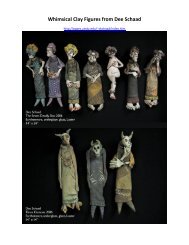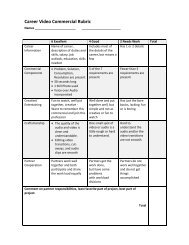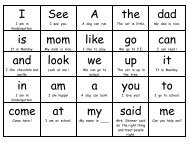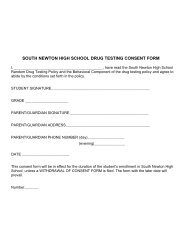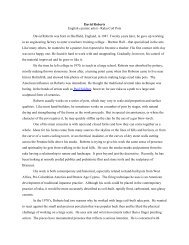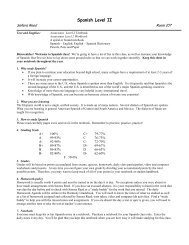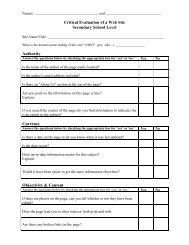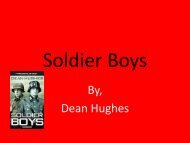A Guide to Writing the Literary Analysis Essay.pdf
A Guide to Writing the Literary Analysis Essay.pdf
A Guide to Writing the Literary Analysis Essay.pdf
Create successful ePaper yourself
Turn your PDF publications into a flip-book with our unique Google optimized e-Paper software.
A <strong>Guide</strong> <strong>to</strong> <strong>Writing</strong> <strong>the</strong> <strong>Literary</strong> <strong>Analysis</strong> <strong>Essay</strong>I. INTRODUCTION: <strong>the</strong> first paragraph in your essay. It begins creatively in order <strong>to</strong>catch your reader’s interest, provides essential background about <strong>the</strong> literary work, andprepares <strong>the</strong> reader for your major <strong>the</strong>sis. The introduction must include <strong>the</strong> author andtitle of <strong>the</strong> work as well as an explanation of <strong>the</strong> <strong>the</strong>me <strong>to</strong> be discussed. O<strong>the</strong>ressential background may include setting, an introduction of main characters, etc. Themajor <strong>the</strong>sis goes in this paragraph usually at <strong>the</strong> end. Because <strong>the</strong> major <strong>the</strong>sissometimes sounds tacked on, make special attempts <strong>to</strong> link it <strong>to</strong> <strong>the</strong> sentence thatprecedes it by building on a key word or idea.A) Creative Opening/Hook: <strong>the</strong> beginning sentences of <strong>the</strong> introduction that catch<strong>the</strong> reader’s interest. Ways of beginning creatively include <strong>the</strong> following:1) A startling fact or bit of information Example: Nearly two hundred citizens were arrested as witches during <strong>the</strong> Salemwitch scare of 1692. Eventually nineteen were hanged, and ano<strong>the</strong>r waspressed <strong>to</strong> death (Marks 65).2) A snatch of dialogue between two characters Example: “It is ano<strong>the</strong>r thing. You [Frederic Henry] cannot know about it unlessyou have it.”“ Well,” I said. “If I ever get it I will tell you [priest].” (Hemingway 72).With <strong>the</strong>se words, <strong>the</strong> priest in Ernest Hemingway’s A Farewell <strong>to</strong> Arms sends<strong>the</strong> hero, Frederic, in search of <strong>the</strong> ambiguous “it” in his life.3) A meaningful quotation (from <strong>the</strong> book you are analyzing or ano<strong>the</strong>r source) Example: “To be, or not <strong>to</strong> be, that is <strong>the</strong> question” {3.1.57}. This familiarstatement expresses <strong>the</strong> young prince’s moral dilemma in WilliamShakespeare’s tragedy Hamlet, Prince of Denmark.4) A universal idea Example: The terrifying scenes a soldier experiences on <strong>the</strong> front probablyfollow him throughout his life—if he manages <strong>to</strong> survive <strong>the</strong> war.5) A rich, vivid description of <strong>the</strong> setting Example: Sleepy Maycomb, like o<strong>the</strong>r Sou<strong>the</strong>rn <strong>to</strong>wns, suffers considerablyduring <strong>the</strong> Great Depression. Poverty reaches from <strong>the</strong> privileged families, like<strong>the</strong> Finches, <strong>to</strong> <strong>the</strong> Negroes and “white trash” Ewells, who live on <strong>the</strong> outskirts of<strong>to</strong>wn. Harper Lee paints a vivid picture of life in this humid Alabama <strong>to</strong>wn wheretempers and bigotry explode in<strong>to</strong> conflict.
B) Thesis: a statement that provides <strong>the</strong> subject and overall opinion of your essay. For aliterary analysis your major <strong>the</strong>sis must(1) relate <strong>to</strong> <strong>the</strong> <strong>the</strong>me of <strong>the</strong> work and(2) suggest how this <strong>the</strong>me is revealed by <strong>the</strong> author. A good <strong>the</strong>sis may alsosuggest <strong>the</strong> organization of <strong>the</strong> paper. Example: Through Paul’s experience behind <strong>the</strong> lines, at a Russian prisoner ofwar camp, and especially under bombardment in <strong>the</strong> trenches, Erich MariaRemarque realistically shows how war dehumanizes a man.Sometimes a <strong>the</strong>sis becomes <strong>to</strong>o cumbersome <strong>to</strong> fit in<strong>to</strong> one sentence. In such cases, youmay express <strong>the</strong> major <strong>the</strong>sis as two sentences. Example: In a Tale of Two Cities, Charles Dickens shows <strong>the</strong> process by whicha wasted life can be redeemed. Sidney Car<strong>to</strong>n, through his love for Lucie Manette,is transformed from a hopeless, bitter man in<strong>to</strong> a hero whose life and death havemeaning.II. BODY PARAGRAPHSA) Body: <strong>the</strong> support paragraphs of your essay. These paragraphs contain supportingExample: (concrete detail) and analysis/explanation (commentary) for your <strong>to</strong>picsentences. Each paragraph in <strong>the</strong> body includes (1) a <strong>to</strong>pic sentence, (2) textual evidence(a.k.a. quotes from your reading) and commentary (a.k.a. explanation), and (3) aconcluding sentence. In its simplest form, each body paragraph is organized as follows:1. <strong>to</strong>pic sentence2. lead-in <strong>to</strong> textual evidence 13. textual evidence 14. commentary5. transition and lead-in <strong>to</strong> textual evidence 26. textual evidence 27. commentary8. concluding or clincher sentence1) Topic Sentence: <strong>the</strong> first sentence of a body or support paragraph. It identifies oneaspect of <strong>the</strong> major <strong>the</strong>sis and states a primary reason why <strong>the</strong> major <strong>the</strong>sis is true. Example: When he first appears in <strong>the</strong> novel, Sidney Car<strong>to</strong>n is a loveless outcastwho sees little worth in himself or in o<strong>the</strong>rs.
2) Textual Evidence: a specific example from <strong>the</strong> work used <strong>to</strong> provide evidence foryour <strong>to</strong>pic sentence. Textual evidence can be a combination of paraphrase and directquotation from <strong>the</strong> work. Example: When Carl<strong>to</strong>n and Darnay first meet at <strong>the</strong> tavern, Carl<strong>to</strong>n tells him, “Icare for no man on this earth, and no man cares for me” (Dickens 105).3) Commentary: your explanation and interpretation of <strong>the</strong> textual evidence.Commentary tells <strong>the</strong> reader what <strong>the</strong> author of <strong>the</strong> text means or how <strong>the</strong> textualevidence proves <strong>the</strong> <strong>to</strong>pic sentence. Commentary may include interpretation, analysis,argument, insight, and/or reflection. (Helpful hint: In your body paragraph, you shouldhave twice as much commentary as textual evidence. In o<strong>the</strong>r words, for every sentenceof textual evidence, you should have at least two sentences of commentary.) Example: Car<strong>to</strong>n makes this statement as if he were excusing his rude behavior<strong>to</strong> Darnay. Car<strong>to</strong>n, however, is only pretending <strong>to</strong> be polite, perhaps <strong>to</strong> amusehimself. With this seemingly off-<strong>the</strong>-cuff remark, Car<strong>to</strong>n reveals a deepercynicism and his emotional isolation.4) Transitions: words or phrases that connect or “hook” one idea <strong>to</strong> <strong>the</strong> next, bothbetween and within paragraphs. Transition devices include using connecting words aswell as repeating key words or using synonyms. Examples: Finally, in <strong>the</strong> climax… Ano<strong>the</strong>r example: …Later in <strong>the</strong> s<strong>to</strong>ry… In contrast <strong>to</strong> this behavior…Not only…but also… Fur<strong>the</strong>rmore…5) Lead-In: phrase or sentence that prepares <strong>the</strong> reader for textual evidence byintroducing <strong>the</strong> speaker, setting, and/or situation. Example: Later, however, when <strong>the</strong> confident Sidney Car<strong>to</strong>n returns alone <strong>to</strong> hishome, his alienation and unhappiness become apparent: “Climbing in<strong>to</strong> a highchamber in a well of houses, he threw himself down in his clo<strong>the</strong>s on a neglectedbed, and its pillow was wet with wasted tears” (Dickens 211).6) Clincher/Concluding Sentence: last sentence of <strong>the</strong> body paragraph. It concludes <strong>the</strong>paragraph by tying <strong>the</strong> textual evidence and commentary back <strong>to</strong> <strong>the</strong> <strong>the</strong>sis. Example: Thus, before Car<strong>to</strong>n experiences love, he is able <strong>to</strong> convince himselfthat <strong>the</strong> world has no meaning.
III. CONCLUSION: last paragraph in your essay. This paragraph should begin byechoing your major <strong>the</strong>sis without repeating <strong>the</strong> words exactly. Then, <strong>the</strong> conclusionshould broaden from <strong>the</strong> <strong>the</strong>sis statements <strong>to</strong> answer <strong>the</strong> “so what?” question your readermay have after reading your essay. The conclusion should do one or more of <strong>the</strong>following:1) Reflect on how your essay <strong>to</strong>pic relates <strong>to</strong> <strong>the</strong> book as a whole2) Evaluate how successful <strong>the</strong> author is in achieving his or her goal or message3) Give a personal statement about <strong>the</strong> <strong>to</strong>pic4) Make predictions5) Connect back <strong>to</strong> your creative opening6) Give your opinion of <strong>the</strong> novel’s value or significanceHOW TO CITE TEXTUAL EVIDENCE WITHIN YOUR PAPERPRIMARY SOURCE: The literary work (novel, play, s<strong>to</strong>ry, poem) <strong>to</strong> be discussed in anessay. Example: : Steinbeck’s Of Mice and MenEdgar Allan Poe’s “The Tell-tale Heart”**For most literary analysis papers, you will be using ONLY PRIMARY SOURCESSECONDARY SOURCE: Any source (o<strong>the</strong>r than <strong>the</strong> primary source) referred <strong>to</strong> in <strong>the</strong>essay. Secondary sources can include critical analyses, biographies of <strong>the</strong> author,reviews, his<strong>to</strong>ry books, encyclopedias etc.When citing primary or secondary sources, follow MLA style for paren<strong>the</strong>ticaldocumentation and “Works Cited” page.WORKS CITED: a separate page listing all <strong>the</strong> works cited in an essay. Itsimplifies documentation because it permits you <strong>to</strong> make only brief references <strong>to</strong>those works in <strong>the</strong> test (paren<strong>the</strong>tical documentation). A “Works Cited” pagediffers from a “Bibliography” in that <strong>the</strong> latter includes sources researched but notactually cited in <strong>the</strong> paper. All <strong>the</strong> entries on a “Works Cited” page are double spaced.PARENTHETICAL DOCUMENTATION: a brief paren<strong>the</strong>tical reference placedwhere a pause would naturally occur <strong>to</strong> avoid disrupting <strong>the</strong> flow of your writing(usually at <strong>the</strong> end of a sentence, before <strong>the</strong> period).Most often you will use <strong>the</strong> author’s last name and page number clearly referring <strong>to</strong> asource listed on <strong>the</strong> “Works Cited” page: Example: Hemingway’s writing declined in his later career (Shien 789).
If you cite <strong>the</strong> author in <strong>the</strong> text of your paper, give only <strong>the</strong> page number in paren<strong>the</strong>ses: Example: According <strong>to</strong> Francis Guerin, The Adventures of Huckleberry Finnreflects “those same nightmarish shadows that even in our own time threaten <strong>to</strong>obscure <strong>the</strong> American Dream” (49).If two works by <strong>the</strong> same author appear in your “Works Cited,” add <strong>the</strong> title or ashortened version of it <strong>to</strong> distinguish your sources: Example: “He wouldn’t rest until he had run a mile or more” (Dickens, A Tale78).BLOCK QUOTATION: quotations that are set off from <strong>the</strong> rest of <strong>the</strong> paper.Indent one-inch from <strong>the</strong> left margin only and double space. Do not use quotationmarks unless <strong>the</strong>y appear in <strong>the</strong> original.1) For a prose quotation of more than 4 typed lines, start <strong>the</strong> quotation after a colon andindent each line of <strong>the</strong> quotation 10 spaces, placing <strong>the</strong> citation after <strong>the</strong> end punctuation. Example:Based on rumors and gossip, <strong>the</strong> children of Maycomb speculate aboutBoo Radley’s appearance:Boo was about six-and-a-half feet tall, judging form his tracks; he dined onraw squirrels and any cats he could catch, that’s why his hands werebloodstained—if you ate an animal raw, you could never wash <strong>the</strong> blood off.There was a long jagged scar that ran across his face; what teeth he had wereyellow and rotten; his eyes popped, and he drooled most of <strong>the</strong> time. (Lee 13)2) For any prose dialogue involving 2 or more speakers, start <strong>the</strong> quotation (dialogue)after a colon and have each line of dialogue as its own paragraph (a 10-spaceindentation), placing <strong>the</strong> citation information after <strong>the</strong> end punctuation. Example:During <strong>the</strong> trial scene, Bob Ewell immediately shows his disrespectfor both <strong>the</strong> court and his family:“Are you <strong>the</strong> fa<strong>the</strong>r of Mayella Ewell?” was <strong>the</strong> next question.“Well, if I ain’t I can’t do nothing about it now, her ma’s dead,” was <strong>the</strong>answer. (Lee 172)
Christine GoesslingMrs. DavisH.S. English 3: Per. 5March 19, 2001Sample <strong>Essay</strong> WithPrimary Source OnlyThe Symbolism of <strong>the</strong> ConchFor centuries philosophers have debated <strong>the</strong> question of whe<strong>the</strong>r man is innatelyevil. William Golding poses this question in his realistic novel Lord of <strong>the</strong> Flies. Set on atropical island during World War II, <strong>the</strong> novel begins when schoolboys from GreatBritain are being flown <strong>to</strong> safety and <strong>the</strong>ir plane is shot down. No adults survive, and <strong>the</strong>boys are left <strong>to</strong> govern <strong>the</strong>mselves and get rescued. William Golding uses symbolism in<strong>the</strong> form of <strong>the</strong> conch <strong>to</strong> represents <strong>the</strong> concept of society. The boys’ evolvingrelationship with <strong>the</strong> conch illustrates Golding’s <strong>the</strong>me that humans, when removed form<strong>the</strong> pressures of civilized authority, will become evil.In <strong>the</strong> beginning, <strong>the</strong> boys view <strong>the</strong> conch as an important symbol that unites <strong>the</strong>mand gives <strong>the</strong>m <strong>the</strong> power <strong>to</strong> deal with <strong>the</strong>ir difficult situation. When <strong>the</strong> conch is firstfound and blown, it brings everyone <strong>to</strong>ge<strong>the</strong>r: “Ralph found his breath and blew a seriesof short blasts. Piggy exclaimed, ‘There’s one!’” (Golding 16). Here Piggy observes oneboy emerging from <strong>the</strong> jungle but soon boys conform all around. Each comes for hisown reason: some for plain curiosity, o<strong>the</strong>r for <strong>the</strong> prospect of rescue. They all form <strong>the</strong>first assembly thanks <strong>to</strong> <strong>the</strong> conch. The first job of this assembly is <strong>to</strong> unite even fur<strong>the</strong>rand choose a leader or chief. Once again <strong>the</strong> conch plays an important part. It is Ralphwho is chosen <strong>to</strong> be chief, and <strong>the</strong> main reason for this is because he holds <strong>the</strong> conch.When it is put <strong>to</strong> a vote, <strong>the</strong> boys exclaim, “Him with <strong>the</strong> shell. Ralph! Ralph! Let him
Goessling 2be chief with <strong>the</strong> trumpet-thing” (Golding 21). Because Ralph possesses <strong>the</strong> conch, asymbol of power and authority, he is chosen chief. Thus, at first <strong>the</strong> conch is animportant object bringing civilizing influences <strong>to</strong> <strong>the</strong> boys as <strong>the</strong>y work <strong>to</strong>ge<strong>the</strong>r <strong>to</strong> make<strong>the</strong> best of a bad situation.Gradually, however, <strong>the</strong> conch becomes less important <strong>to</strong> <strong>the</strong> boys, signifying<strong>the</strong>ir gradual turn <strong>to</strong> evil. When <strong>the</strong> boys first start a fire on <strong>to</strong>p of <strong>the</strong> mountain, Piggyholds <strong>the</strong> conch and attempts <strong>to</strong> speak. But Jack rebukes him by saying, “The conchdoesn’t count on <strong>to</strong>p of <strong>the</strong> mountain, so you shut up” (Golding 39). Boys like Jackbegin <strong>to</strong> place limitations on <strong>the</strong> conch and lose respect for it and one ano<strong>the</strong>r. Then oneday at an assembly, Jack places even less importance on <strong>the</strong> conch excluding more of <strong>the</strong>boys and thus diminishing <strong>the</strong> democratic order and authority that <strong>the</strong> conch provides.He says, “We don’t need <strong>the</strong> conch any more. We know who ought <strong>to</strong> say thins…It’stime some people knew <strong>the</strong>y’ve got <strong>to</strong> keep quiet and leave deciding things <strong>to</strong> <strong>the</strong> rest ofus” (Golding 92). Jack’s assertion here clearly connects <strong>the</strong> demise of <strong>the</strong> conch <strong>to</strong> achange in <strong>the</strong> social order. Jack is slowly becoming a power-hungry dicta<strong>to</strong>r, and we wee<strong>the</strong> orderly influence of <strong>the</strong> conch replaced by man’s evil impulses.In <strong>the</strong> end, <strong>the</strong> conch loses significance <strong>to</strong> all but Piggy, and most of <strong>the</strong> boys turnin<strong>to</strong> evil savages. Piggy tells Ralph <strong>to</strong> call an assembly, and Ralph only laughs. Finally,after Piggy’ glasses are s<strong>to</strong>len, he tells Ralph, “Blow <strong>the</strong> conch, blow as loud as you can.”The forest reechoed; and birds lifted, crying out of <strong>the</strong> tree<strong>to</strong>ps, as on that first morningages ago” (Golding 154). Piggy believes that <strong>the</strong> authority of <strong>the</strong> conch will once again
Goessling 3bring <strong>the</strong> boys <strong>to</strong>ge<strong>the</strong>r, but only four boys meet in this assembly. The rest have joinedJack’s savage tribe. The goal of <strong>the</strong>ir last assemble is <strong>to</strong> get Piggy’s glasses back formJack. Therefore, <strong>the</strong> assembly moves <strong>to</strong> Castle Rock where Roger, <strong>the</strong> <strong>to</strong>rturer andexecutioner of Jack’s group, rolls a boulder off <strong>the</strong> mountain and puts an end <strong>to</strong> <strong>the</strong> conchand its one true supporter:The rock struck Piggy a glancing blow form chin <strong>to</strong> knee; <strong>the</strong> conchexploded in<strong>to</strong> a thousand white fragments and ceased <strong>to</strong> exist. Piggy,saying nothing, with no time for even a grunt, traveled through <strong>the</strong> airsideways form <strong>the</strong> rock, turning over as he went…Piggy fell forty feet andlanded on his back across <strong>the</strong> square red rock in <strong>the</strong> sea. His head openedand stuff came out and turned red. (Golding 164-165)It is fitting here that <strong>the</strong> destruction of <strong>the</strong> conch accompanies <strong>the</strong> boys’ first intentionalact of murder on <strong>the</strong> island. Thus <strong>the</strong>ir final descent in<strong>to</strong> evil is complete. Now, with <strong>the</strong>authority of <strong>the</strong> conch destroyed, Jack’s group is given license <strong>to</strong> become <strong>to</strong>tal savages.The next day, <strong>the</strong>y would hut Ralph <strong>to</strong> kill him, thus leaving behind <strong>the</strong> civilizinginfluences of <strong>the</strong> conch forever.Golding uses <strong>the</strong> conch shell <strong>to</strong> show <strong>the</strong> slow slide of <strong>the</strong> boys in<strong>to</strong> savagery,<strong>the</strong>reby exemplifying <strong>the</strong> <strong>the</strong>me that humans have <strong>the</strong> capability <strong>to</strong> turn evil. At first, <strong>the</strong>conch brings everyone <strong>to</strong>ge<strong>the</strong>r; <strong>the</strong>n, as its power erodes, <strong>the</strong> group breaks in<strong>to</strong> two.Finally, <strong>the</strong> destruction of <strong>the</strong> conch signals <strong>the</strong> plunge in<strong>to</strong> <strong>to</strong>tal savagery. By following<strong>the</strong> role of <strong>the</strong> conch in <strong>the</strong> s<strong>to</strong>ry, we see how Golding uses it <strong>to</strong> unify <strong>the</strong> central eventsof <strong>the</strong> s<strong>to</strong>ry around his <strong>the</strong>me of inevitable evil. Golding is an artist, not a philosopher,
Goessling 4but through his art he answers <strong>the</strong> question debated for centuries by philosophers: Is maninnately evil? According <strong>to</strong> Lord of <strong>the</strong> Flies, he is.Goessling 5Works CitedGolding, William. Lord of <strong>the</strong> Flies. New York: The Putnam Publishing Group, 1954.**This guide has been adapted from “A <strong>Guide</strong> <strong>to</strong> <strong>Writing</strong> <strong>the</strong> <strong>Literary</strong> <strong>Analysis</strong> <strong>Essay</strong>” at:http://powayusd.sdcoe.k12.ca.us/pusdrbhs/academics/english/curriculum/literaryguide.<strong>pdf</strong>



